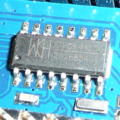Differences
This shows you the differences between two versions of the page.
| Both sides previous revision Previous revision Next revision | Previous revision | ||
|
boards:demov1 [2022/11/12 20:59] darron [STM32F030 DEMO BOARD V1.0] |
boards:demov1 [2022/11/21 13:48] (current) darron |
||
|---|---|---|---|
| Line 5: | Line 5: | ||
| {{: | {{: | ||
| \\ \\ | \\ \\ | ||
| - | {{: | + | {{: |
| \\ \\ | \\ \\ | ||
| {{boards: | {{boards: | ||
| Line 53: | Line 53: | ||
| SPI1 MISO PA6 | SPI1 MISO PA6 | ||
| SPI1 MOSI PA7 | SPI1 MOSI PA7 | ||
| + | </ | ||
| + | |||
| + | ===Clocks=== | ||
| + | |||
| + | < | ||
| + | HSE 8000000 X1 8MHz | ||
| + | HSI 8000000 | ||
| + | LSE 0 N/A | ||
| + | LSI 32768 | ||
| </ | </ | ||
| === Power === | === Power === | ||
| - | Power is supplied on the USB socket | + | |
| + | Power is supplied on the USB socket | ||
| + | |||
| + | The USB socket does not support I/O, it's only for powering the device. | ||
| === Test === | === Test === | ||
| - | Test SWD with J-Link | + | For testing this board use a [[interfaces: |
| + | reset and a source or external interrupt. Picocom is used to control the reset | ||
| + | pin and provide a pulse for testing STM32 EXTI. | ||
| + | |||
| + | For programming, | ||
| + | |||
| + | ==Wiring== | ||
| + | |||
| + | < | ||
| + | | ||
| + | | ||
| + | | ||
| + | USB| UM232R |RTS# | ||
| + | | ||
| + | | ||
| + | | ||
| + | | ||
| + | | ||
| + | USB| JLINK/ |DIO-----------DIO | ||
| + | | CLONE |CLK-----------CLK | ||
| + | | ||
| + | |||
| + | USB on left is RPi host and USB on right is USB 5V pin on UM232R. | ||
| + | </ | ||
| + | |||
| + | ==Comms== | ||
| + | |||
| + | The lower-rts option to picocom will take the board out of | ||
| + | reset and run the program. | ||
| + | |||
| + | < | ||
| + | picocom --quiet --lower-rts -b 115200 / | ||
| + | </ | ||
| + | |||
| + | From the RS232 perspective RTS is inverted so when picocom takes | ||
| + | the line low, it's actually a high logical output and the board | ||
| + | is taken out of reset. | ||
| + | |||
| + | ==Reset== | ||
| + | |||
| + | Picocom CTRL A CTRL G will toggle the RTS line state. | ||
| + | |||
| + | ==Reboot== | ||
| + | |||
| + | If the board is sleeping, picocom can reboot the board to prepare | ||
| + | it for new programming. | ||
| + | |||
| + | < | ||
| + | picocom --quiet --lower-rts --baud 115200 --exit-after 0 / | ||
| + | </ | ||
| + | |||
| + | ==Pulse== | ||
| + | |||
| + | Picocom CTRL A CTRL P will pulse the DTR pin from low to high for | ||
| + | 1 second to test EXTI high or low edge. | ||
| + | |||
| + | === Programming === | ||
| + | |||
| + | Use SWD with J-Link | ||
| ==J-Link== | ==J-Link== | ||

